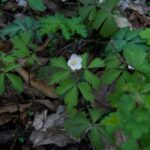wood anemone
Anemone quinquefolia

Description:
Anemone quinquefolia is a perennial herb that typically grows to be about 6-12 inches tall. The plant has delicate, white or pink flowers that bloom in the spring. Each flower has 5-20 petals that are 1-2 cm in diameter. The flowers are held on slender stalks above the leaves and bloom from April to June. The leaves are glossy, green, and deeply lobed, with 3-5 lobes. The leaves emerge from the base of the plant and are arranged in a basal rosette.
Anemone quinquefolia is native to North America and can be found growing in a variety of habitats, including woodlands, along streams, and in other damp locations. It prefers shaded or partially shaded areas and grows well in well-drained, moist soils. It can be found in the wild from Newfoundland to the Northwest Territories and south to the mountains of Georgia and Arizona. It is common in the woodlands across Wisconsin.
Details:
wood anemone
References:
- Lady Bird Johnson Wildflower Center Database – Anemone quinquefolia
- USDA Plants Database – Anemone quinquefolia
- Wisflora Database – Anemone quinquefolia
Return to Native Plants page
